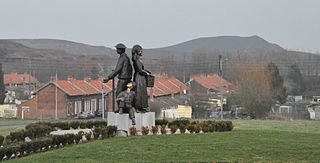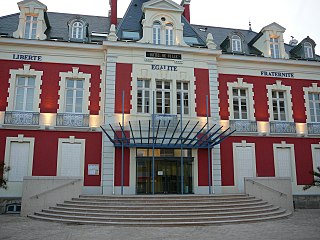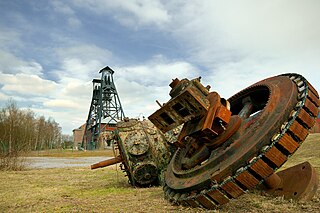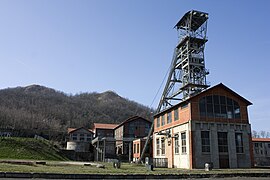
Nord is a department in Hauts-de-France region, France bordering Belgium. It was created through the merger of the majority of the provinces of French Flanders, French Hainaut, and Cambrésis, plus a small part of Picardy. The modern coat of arms was inherited from the County of Flanders.

The Ruhr, also referred to as the Ruhr area, sometimes Ruhr district, Ruhr region, or Ruhr valley, is a polycentric urban area in North Rhine-Westphalia, Germany. With a population density of 2,800/km2 and a population of over 5 million (2017), it is the largest urban area in Germany. It consists of several large cities bordered by the rivers Ruhr to the south, Rhine to the west, and Lippe to the north. In the southwest it borders the Bergisches Land. It is considered part of the larger Rhine-Ruhr metropolitan region of more than 10 million people, which is the third largest in Europe, behind only London and Paris.

Coal mining is the process of extracting coal from the ground. Coal is valued for its energy content and since the 1880s has been widely used to generate electricity. Steel and cement industries use coal as a fuel for extraction of iron from iron ore and for cement production. In the United Kingdom and South Africa, a coal mine and its structures are a colliery, a coal mine is called a 'pit', and the above-ground structures are a 'pit head'. In Australia, "colliery" generally refers to an underground coal mine.

Auchel is a commune in the Pas-de-Calais department in the Hauts-de-France region in northern France.

Forbach is a commune in the French department of Moselle, northeastern French region of Grand Est.
The history of coal mining goes back thousands of years, with early mines documented in ancient China, the Roman Empire and other early historical economies. It became important in the Industrial Revolution of the 19th and 20th centuries, when it was primarily used to power steam engines, heat buildings and generate electricity. Coal mining continues as an important economic activity today but has begun to decline due to the strong contribution coal plays in global warming and environmental issues, which result in decreasing demand and in some geographies, peak coal.

Decazeville is a commune in the Aveyron department in the Occitanie region in southern France.

Montceau-les-Mines is a commune in the Saône-et-Loire department in the region of Bourgogne-Franche-Comté in eastern France.

Borken is a small town with about 13,000 inhabitants in the Schwalm-Eder district in northern Hesse, Germany.

Courcelles-lès-Lens is a commune in the Pas-de-Calais department in the Hauts-de-France region of France.

Libercourt is a commune in the Pas-de-Calais department in the Hauts-de-France region of France.

Nœux-les-Mines is a commune in the Pas-de-Calais department in the Hauts-de-France region of France.

Pingxi District, is a rural district in New Taipei, Taiwan. The source of the Keelung River is in Jingtong, which is inside Pingxi District. It was an important coal mining town in the early 20th century. Its population of 4,872 as of January 2016 is the smallest among the districts of New Taipei City.

Coal mining in the United Kingdom dates back to Roman times and occurred in many different parts of the country. Britain's coalfields are associated with Northumberland and Durham, North and South Wales, Yorkshire, the Scottish Central Belt, Lancashire, Cumbria, the East and West Midlands and Kent. After 1972, coal mining quickly collapsed and had practically disappeared by the 21st century. The consumption of coal – mostly for electricity – fell from 157 million tonnes in 1970 to 18 million tonnes in 2016, of which 77% was imported from Colombia, Russia, and the United States. Employment in coal mines fell from a peak of 1,191,000 in 1920 to 695,000 in 1956, 247,000 in 1976, 44,000 in 1993, and to 2,000 in 2015.

The Major Mining Sites of Wallonia is a UNESCO World Heritage Site comprising four sites in Wallonia in southern Belgium associated with the Belgian coal mining industry of the 19th and 20th centuries. The four sites of the grouping, situated in the French-speaking Hainaut Province and Liège Province, comprise Grand-Hornu, the Bois-du-Luc, the Bois du Cazier and Blegny-Mine.

The Nord-Pas-de-Calais Mining Basin is a mining basin in Northern France that stretches across the Nord and Pas-de-Calais departments. The region is famous for its long history of coal extraction and its testimony to a significant period in the history of industrialisation in Europe, and as a result it was inscribed on the UNESCO World Heritage List in 2012. This area has been shaped by three centuries of coal extraction from the late 17th century through the 20th century, and demonstrates the evolution of coal mining techniques and worker conditions during that time.

The Ronchamp Coal Mines were an area of coal mines located in the Vosges and Jura coal mining basins, in eastern France. They covered three municipalities; Ronchamp, Champagney and Magny-Danigon. Operated for more than two centuries, from the mid-eighteenth century until the mid-twentieth century, they have profoundly changed the landscape, the economy and the local population.

Mining has been practiced in Taiwan for hundreds of years. Sulfur was an early important resource collected on the island. Coal mining expanded in the 19th century to keep up with demand from increased foreign trade. Heavy industry was further expanded under Japanese rule, but air raids towards the end of World War II decimated mining infrastructure, falling below 19th century production levels. Copper mining expanded in the mid-20th century, but ended in the 1980s following a global collapse in the price of copper.

Saar-Warndt coal mining basin is an area of Germany and France. It has been shaped by two centuries of coal extraction from the start of the 19th century to the start of 21st century; and it represents a significant period in the history of European industrialisation.

The Vosges and Jura coal mining basins are an area of France located between two mountain ranges, that has been shaped by four centuries of coal extraction from the 16th Century to the 20th Century. It includes four coal basins in three geographic locations.






















